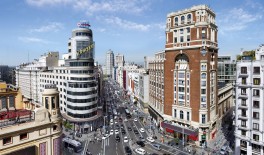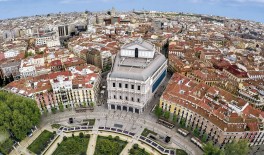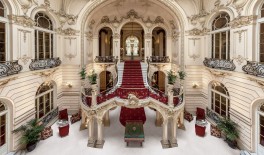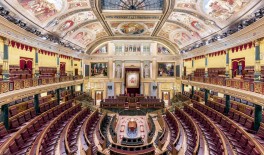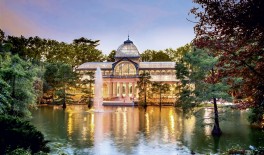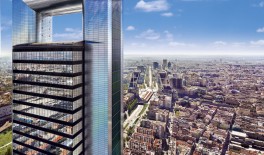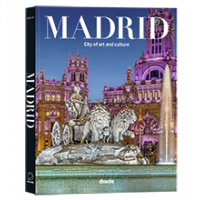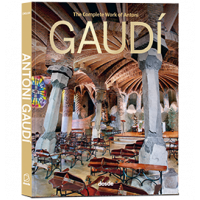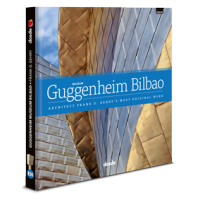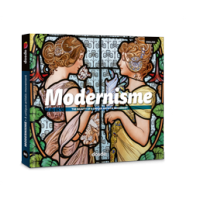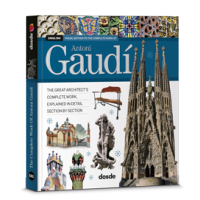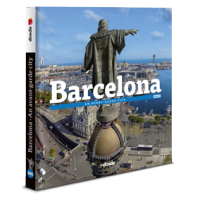Madrid
A great european capital
RETURN
About the book Madrid
This book on Madrid published by Dosde is a complete photographic journey around the most important places and monuments of the city. Its pages show the emblematic corners of a unique metropolis, which stands out for its exceptional artistic and architectural heritage.
The book is divided into 6 chapters, each one of them focused on a certain area of the city. Thus, the book, which includes more than 280 pictures of Madrid and its emblematic monuments, explores the old quarter today transformed into the heart of the so-called Hapsburg Madrid, and the new neighbourhoods that have recently sprung up on the outskirts, providing a broad panorama of the Spanish capital.
Likewise, the Madrid pictures included in the book are accompanied by texts that provide very comprehensive information on the historical evolution of the city and the origin of its different neighbourhoods and more representative buildings.
This combination of photos and text make it possible to get a new perspective on one of the most important cities in Europe. The vision of this work can also be extended with other books published by Dosde.
The book is divided into 6 chapters, each one of them focused on a certain area of the city. Thus, the book, which includes more than 280 pictures of Madrid and its emblematic monuments, explores the old quarter today transformed into the heart of the so-called Hapsburg Madrid, and the new neighbourhoods that have recently sprung up on the outskirts, providing a broad panorama of the Spanish capital.
Likewise, the Madrid pictures included in the book are accompanied by texts that provide very comprehensive information on the historical evolution of the city and the origin of its different neighbourhoods and more representative buildings.
This combination of photos and text make it possible to get a new perspective on one of the most important cities in Europe. The vision of this work can also be extended with other books published by Dosde.
Photo Edition
Madrid
It includes exclusive digital content
Made with environmentally friendly paper
Multilanguage: Available in 3 languages
More than 280 top quality photographs
About the book Madrid
This book on Madrid published by Dosde is a complete photographic journey around the most important places and monuments of the city. Its pages show the emblematic corners of a unique metropolis, which stands out for its exceptional artistic and architectural heritage.
The book is divided into 6 chapters, each one of them focused on a certain area of the city. Thus, the book, which includes more than 280 pictures of Madrid and its emblematic monuments, explores the old quarter today transformed into the heart of the so-called Hapsburg Madrid, and the new neighbourhoods that have recently sprung up on the outskirts, providing a broad panorama of the Spanish capital.
Likewise, the Madrid pictures included in the book are accompanied by texts that provide very comprehensive information on the historical evolution of the city and the origin of its different neighbourhoods and more representative buildings.
This combination of photos and text make it possible to get a new perspective on one of the most important cities in Europe. The vision of this work can also be extended with other books published by Dosde.
The book is divided into 6 chapters, each one of them focused on a certain area of the city. Thus, the book, which includes more than 280 pictures of Madrid and its emblematic monuments, explores the old quarter today transformed into the heart of the so-called Hapsburg Madrid, and the new neighbourhoods that have recently sprung up on the outskirts, providing a broad panorama of the Spanish capital.
Likewise, the Madrid pictures included in the book are accompanied by texts that provide very comprehensive information on the historical evolution of the city and the origin of its different neighbourhoods and more representative buildings.
This combination of photos and text make it possible to get a new perspective on one of the most important cities in Europe. The vision of this work can also be extended with other books published by Dosde.
Videos Madrid
No reviews yet.
Additional Information
- Additional Information
- Subtitle: A great european capital
- Weight (g): 540
- Binding: Paperback with flaps
- Size (cm): 19,5 x 17,5
- Author: Dosde
- Pages: 0
- Edition: Photo Edition
Things to do in Madrid
Considered one of the great European capitals, Madrid is a city with centuries of history and a wealth of cultural and architectonic heritage. The streets of Madrid blend tradition and modernity, in a city that looks to the future without renouncing its past.
The city boasts majestic buildings of great architectural value, such as the Royal Palace, Madrid Casino and the Cibeles Palace. As the capital of Spain, Madrid is the headquarters of institutions such as the Congress of Deputies, the Bank of Spain or the government ministries.
The importance of the city is also demonstrated by its wide cultural offer, which includes institutions such as the Teatro Real, the Thyssen Museum and the Prado Museum, whose art exhibitions are visited every year by millions of people.
As well as regularly hosting markets and fairs, within its arcades the first unions in the city were established, who offered their wares to the locals and visitors from nearby towns. Moreover, the square has played host to large celebrations and multitudinous events, ranging from royal proclamations to public executions, religious processions, bullfights and theatrical works. At present, the square continues to host events of great relevance for Madrilenean social life.
Near to the Plaza Mayor are other striking spaces in the city, such as the Mercado de San Miguel, an absolute must for local food lovers, the Plaza de la Villa, where the originial headquarters of the Town Hall is, and Puerta del Sol, the symbolic centre of Spanish geography.
Opposite the Royal Palace is the Cathedral of the Almudena, a temple of monumental dimensions that combines a neoclassical style exterior with a gothic style interior. This aesthetic variety reflects the long construction process of the building, which was started in the late 19th century and continued until 1993.
In the surroundings of the Royal Palace there is is also the Teatro Real (Royal Theatre), one of the centres of reference for the international opera scene. Subject to various refurbishments, the building was built at the start of the 19th century, within the framework of the Plaza de Oriente development project.
The square took on its present layout in the year 1895, when it was redesigned to make carriage circulation easier. In its centre is the famous fountain, which it is named after, created in the second half of the eighteenth century as part of the urban development plan instigated by King Charles III.
Converted into one of the most recognisable pictures of Madrid, the monument dedicated to the goddess Cybele was designed in 1776 by architect Ventura Rodríguez, although it was sculpted by Francisco Gutiérrez, Roberto Michel and Miguel Jiménez.
One of the sites that just can't be missed in Madrid is the Paseo del Prado, a leafy avenue that evolved in the 18th century within the framework of an ambitious development project instigated by King Charles III.
In the avenue's close surroundings are some of the most important art galleries of Spain, such as the Thyssen-Bornemisza Museum, the National Museum Centre of Art Reina Sofia and, above all, the Prado Museum, whose collection includes masterpieces from artists such as Velázquez, Goya, Rubens and Tintoretto.
Next to the Paseo del Prado there is the Retiro Park, which, with a surface area of around 118 hectares, constitutes the large green area of the city. The park arose in 1630, when Gaspar de Guzmán, Count-Duke of Olivares, gave Philip IV some land near the Monastery of San Jerónimo el Real so that a recreational palace surrounded by gardens could be constructed there.
Known as the Buen Retiro, the site was used exclusively by the Spanish monarchy until the eighteenth century, when Charles III decided to permit public access to part of the gardens.
After several renovation attempts aimed at restoring the gardens to their former splendour, in 1868 the site became the property of the City Council, which meant it could be used by the public on a permanent basis.
Thus, the first section of the avenue, which runs between Calle de Alcalá and the Red de San Luis, brings together numerous examples of historicist and regionalist styles that triumphed in the city in the first quarter of the twentieth century, while the second stretch, which reaches Plaza del Callao, shows the impact of American architecture in the 1920s.
As for the stretch that ends in the Plaza de España –popularly known as “Broadway Madrid” for its theatres– it has a less monumental profile, with plainer buildings of rationalist style.
The city boasts majestic buildings of great architectural value, such as the Royal Palace, Madrid Casino and the Cibeles Palace. As the capital of Spain, Madrid is the headquarters of institutions such as the Congress of Deputies, the Bank of Spain or the government ministries.
The importance of the city is also demonstrated by its wide cultural offer, which includes institutions such as the Teatro Real, the Thyssen Museum and the Prado Museum, whose art exhibitions are visited every year by millions of people.
The historical centre
One of the most representative Madrid pictures is that of Plaza Mayor, at the heart of the so-called Hapsburg Madrid, the area of the city which stretches from Plaza de Oriente to the Puerta del Sol. The square acquired its present layout in the first half of the 18th century, by means of renovation work promoted by King Philip III.As well as regularly hosting markets and fairs, within its arcades the first unions in the city were established, who offered their wares to the locals and visitors from nearby towns. Moreover, the square has played host to large celebrations and multitudinous events, ranging from royal proclamations to public executions, religious processions, bullfights and theatrical works. At present, the square continues to host events of great relevance for Madrilenean social life.
Near to the Plaza Mayor are other striking spaces in the city, such as the Mercado de San Miguel, an absolute must for local food lovers, the Plaza de la Villa, where the originial headquarters of the Town Hall is, and Puerta del Sol, the symbolic centre of Spanish geography.
The royal city
In any photo album with pictures of Madrid there will always be views of the Palacio Real (Royal Palace), the main symbol of the historical link between the city and the monarchy. The palace was built in the eighteenth century on the initiative of Philip V, shortly after a fire severely damaged the structure of the old Alcazar, and it sets the scene for royal power through its architectonic design, considered a landmark in the Classical Baroque style.Opposite the Royal Palace is the Cathedral of the Almudena, a temple of monumental dimensions that combines a neoclassical style exterior with a gothic style interior. This aesthetic variety reflects the long construction process of the building, which was started in the late 19th century and continued until 1993.
In the surroundings of the Royal Palace there is is also the Teatro Real (Royal Theatre), one of the centres of reference for the international opera scene. Subject to various refurbishments, the building was built at the start of the 19th century, within the framework of the Plaza de Oriente development project.
Plaza de Cibeles
Located on the intersection of Calle de Alcalá with Paseo de Recoletos and Paseo del Prado, the square dominated by a monumental fountain dedicated to the goddess Cybele is one of the most emblematic spaces in the Spanish capital.The square took on its present layout in the year 1895, when it was redesigned to make carriage circulation easier. In its centre is the famous fountain, which it is named after, created in the second half of the eighteenth century as part of the urban development plan instigated by King Charles III.
Converted into one of the most recognisable pictures of Madrid, the monument dedicated to the goddess Cybele was designed in 1776 by architect Ventura Rodríguez, although it was sculpted by Francisco Gutiérrez, Roberto Michel and Miguel Jiménez.
The Art Avenue
One of the sites that just can't be missed in Madrid is the Paseo del Prado, a leafy avenue that evolved in the 18th century within the framework of an ambitious development project instigated by King Charles III.In the avenue's close surroundings are some of the most important art galleries of Spain, such as the Thyssen-Bornemisza Museum, the National Museum Centre of Art Reina Sofia and, above all, the Prado Museum, whose collection includes masterpieces from artists such as Velázquez, Goya, Rubens and Tintoretto.
Next to the Paseo del Prado there is the Retiro Park, which, with a surface area of around 118 hectares, constitutes the large green area of the city. The park arose in 1630, when Gaspar de Guzmán, Count-Duke of Olivares, gave Philip IV some land near the Monastery of San Jerónimo el Real so that a recreational palace surrounded by gardens could be constructed there.
Known as the Buen Retiro, the site was used exclusively by the Spanish monarchy until the eighteenth century, when Charles III decided to permit public access to part of the gardens.
After several renovation attempts aimed at restoring the gardens to their former splendour, in 1868 the site became the property of the City Council, which meant it could be used by the public on a permanent basis.
Gran Vía
The avenue created at the start of the 20th century to provide fresh air in the centre of the city provided the scene of the most cosmopolitan pictures of Madrid. Renowned for its wide commercial and entertainment offer, Gran Vía is made up of three sections of irregular layout developed in different historical periods that constitute a faithful reflection of the evolution of architectural tastes.Thus, the first section of the avenue, which runs between Calle de Alcalá and the Red de San Luis, brings together numerous examples of historicist and regionalist styles that triumphed in the city in the first quarter of the twentieth century, while the second stretch, which reaches Plaza del Callao, shows the impact of American architecture in the 1920s.
As for the stretch that ends in the Plaza de España –popularly known as “Broadway Madrid” for its theatres– it has a less monumental profile, with plainer buildings of rationalist style.

